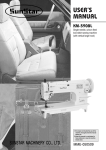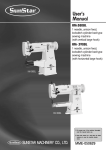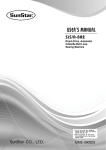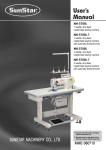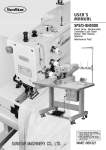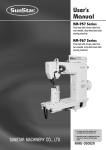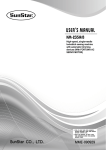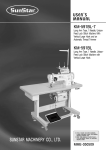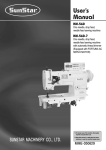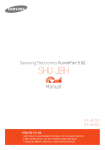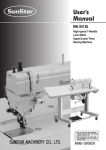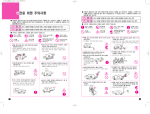Download User`s Manual
Transcript
User’s Manual KM-815 Series KM-825 Series High post, High speed, one-two needle, sewing machine 1) For proper use of the machine, thoroughly read this manual before use. SUNSTAR MACHINERY CO., LTD. 2) Keep this manual in a safe place for future reference in case the machine breaks down. MME-050509 lity a u tQ Besst Pricevice Be st Ser Be 1. Thank you for purchasing our product. Based on the rich expertise and experience accumulated in industrial sewing machine production, SUNSTAR will manufacture industrial sewing machines, which deliver more diverse functions, high performance, powerful operation, enhanced durability, and more sophisticated design to meet a number of user’s needs. 2. Please read this user’s manual thoroughly before using the machine. Make sure to properly use the machine to enjoy its full performance. 3. The specifications of the machine are subject to change, aimed to enhance product performance, without prior notice. 4. This product is designed, manufactured, and sold as an industrial sewing machine. It should not be used for other than industrial purpose. R SUNSTAR MACHINERY CO., LTD. Table of contents Safety rules for machine ...................................................................................................... 4 1. Specification..................................................................................................................... 8 1) Sewing machine .......................................................................................................................................................... 8 2) Clutch motor................................................................................................................................................................ 8 2. Installation ........................................................................................................................ 9 1) Installation of oil pan .................................................................................................................................................. 9 2) Installation of machine head..................................................................................................................................... 10 3) Lubrication ................................................................................................................................................................ 11 4) Adjustment of belt tension........................................................................................................................................ 12 5) Installation of belt cover ........................................................................................................................................... 12 3. Adjusting the machine ................................................................................................... 13 1) Inserting needle ......................................................................................................................................................... 13 2) Removing bobbin...................................................................................................................................................... 13 3) Inserting bobbin ........................................................................................................................................................ 14 4) Routing upper thread................................................................................................................................................. 14 5) Adjusting thread tension ........................................................................................................................................... 15 A. Adjusting the upper thread tension B. Adjusting the lower thread tension C. Adjusting the thread take up spring tension 6) Adjusting roller presser foot height and pressure .................................................................................................... 16 A. Adjusting the height of the presser foot B. Adjusting the pressure of the presser foot 7) Rotating roller shaft .................................................................................................................................................. 17 8) Adjusting stitch length .............................................................................................................................................. 17 9) Adjusting timing of needle and feed dog ................................................................................................................. 18 10) Adjusting height of feed dog .................................................................................................................................. 18 11) Adjusting timing of needle and hook ..................................................................................................................... 19 A. Adjusting clearance between needle and edge of hook B. Adjusting ascending level of needle bar C. Adjusting height of needle bar 12) Adjusting clearance between hook and opener ..................................................................................................... 20 13) Exchanging needle width gauge set ....................................................................................................................... 20 4. Causes of Trouble and Troubleshooting....................................................................... 21 1) Sewing machine troubleshooting ............................................................................................................................. 21 Safety Rules for Machine Safety labels in the manual are categorized into danger, warning and caution. Failure to follow the safety rules may result in physical injuries or mechanical damages. The safety labels and symbols are defined as follows. [The meaning of the safety labels] Danger Instructions here shall be observed strictly. Otherwise, the user will be killed or suffer severe physical injuries Warning Instructions here must be observed, or the user could suffer fatal or severe physical injuries. Caution Instructions here should be observed, or the user could face physical injuries or mechanical damages. [The meaning of symbols] This symbol means a must-not. This symbol means a must for safety. This symbol means that an electric shock may be caused if the instruction is not followed properly. 4 1-1) Machine mobilization Only personnel with a full understanding of the safety rules should move the machines. The following directions must be observed when delivering the machines. ⓐ At least two persons should work together. ⓑ In case the machine should be transported, please wipe the oil covered on the machine to prevent accidents. Danger 1-2) Machine Installation Caution Because physical damage such as the functional obstacles and breakdowns are likely to occur according to the environment in which the machine is being installed. Therefore, the following preconditions should be fulfilled. ⓐ Please keep the order from top to bottom when unpacking the package. Especially, mind that the nail on the boxes. ⓑ Because machines are apt to be contaminated and corroded by dust and moisture, you should install the climate controller and should clean the machines regularly. ⓒ Keep the machines out of the direct rays of the sun. ⓓ Keep both sides and the backside of the machines off at least 50cm from the wall to secure enough space to repair. ⓔ Danger of Explosion. Don’t run the machine near the places with the dangers of explosion. Don’t run the machine near the places with the dangers of explosion, including the places where the spraying product like aerosol are used in large quantities or oxygen are dealt with, unless the exact actions concerning the operation are guaranteed to avoid the explosion. ⓕ Because of the peculiarity of the machine, any illuminators are not equipped. So, users should install the lighting apparatus around the working area. [Note] The details about the installment of the machine are described in No. 2 Installations. 1-3) Troubleshooting Danger In need of troubleshooting, it should be done by the trained A/S engineer of our company. ⓐ Ahead of cleaning and repair, be sure to shut off the power supply. And wait for about 4 minutes till the machine discharges completely. ⓑ Even a part or all of the machine should not be modified without any consultation with our company. ⓒ In case of repair, you should change the damaged part into the standard article of our company. ⓓ After repair, please put again the safety cover disjointed while repairing. 5 1-4) Machine Operation Warning KM-815/825 series are manufactured for industry use to sew textiles and other similar material. In case of running the machine, users should observe the following things. ⓐ Ahead of operating the machine, please read the manual and understand fully the details on its operation. ⓑ Don’t forget to put on the garment suited for the safe work. ⓒ Keep your hands or a part of the body away from the running part of the machine like a needle, hook, thread take-up spring and pulley etc. ⓓ Don’t remove any kind of cover for safety while running the machine. ⓔ Be sure to connect the earthed line. ⓕ Before opening the electric box such as a control box, be sure to shut off the power supply and make sure that the power switch should be put on “off.” ⓖ When threading the needle or before checking after sewing, be sure to stop the machine. ⓗ Don’t switch on the power supply with the foot on the pedal. ⓘ Don’t run the machine when the cooling fan are not running. Be sure to clean the air filter in the control box once a week. ⓙ If possible, keep off from the strong electronic wave like a high frequency welding machine. Warning 1-5) Safety Device Warning Always start the machine with safety covers in place since fingers or hands could be injured or cut off by the belt. Turn off the power switch during check-ups or adjustments. ⓐ Safety Label: Suggestions while running the machine are stated. ⓑ Thread take-up spring cover: the device to prevent the human body from touching the thread take-up spring. ⓒ Belt cover: the device to prevent hands, feet and clothing from getting jammed by the belt. ⓓ Finger guard: the device to prevent fingers from contacting the needle. ⓑ ⓐ ⓒ ⓓ 6 1-6) Position of Caution Mark CAUTION 경 고 “Caution” is attached to the machine for safety. In case of starting to run the machine, read the directions of “Cautions” carefully. [Position of Caution Mark] Do not operate without finger guard and safety devices. Before threading, changing bobbin and needle, cleaning etc. switch off main switch. 손가락 보호대와 안전장치 없이 작동하지 마십시오. 실, 보빈, 바늘교환시나 청소전에는 반드시 주전원의 스위치를 꺼 주십시오. CAUTION 경 고 Hazardous voltage will cause injury. Be sure to wait at least 360 seconds before opening this cover after turn off main switch and unplug a power cord. 고압 전류에 의해 감전될 수 있으므로 커버를 열 때는 전원을 내리고 전원 플러그를 뽑고 나서 360초간 기다린 후 여십시오. 1-7) Content of “Caution” Caution CAUTION 경 고 Do not operate without finger guard and safety devices. Before threading, changing bobbin and needle, cleaning etc. switch off main switch. 손가락 보호대와 안전장치 없이 작동하지 마십시오. 실, 보빈, 바늘교환시나 청소전에는 반드시 주전원의 스위치를 꺼 주십시오. CAUTION 경고 Hazardous voltage will cause injury. Be sure to wait at least 360 seconds before opening this cover after turn off main switch and unplug a power cord. 고압 전류에 의해 감전될 수 있으므로 커버를 열 때는 전원을 내리고 전원 플러그를 뽑고 나서 360초간 기다린 후 여십시오. 7 1 Specification 1) Sewing machine MODEL KM-815 KM-825 HEAVY MATERIALS HEAVY MATERIALS 1 2 NEEDLE DP 5 # 19 DP 5 # 19 SPEED MAX 3,000 S.P.M MAX 3,000 S.P.M MAX 5mm MAX 5mm NEEDLE BAR STROKE 33.4mm 33.4mm THREAD TAKE UP 61.5mm 61.5mm 7mm 7mm 11mm 11mm 178mm 178mm DROP-OILER DROP-OILER USAGE STITCH LENGTH STITCH WIDTH ASENDING OF MANUAL PRESSUER KNEE LIFT FOOT HEIGHT OF POST LUBRICATION ROLLER PRESSER FOOT 1/16 ,3/32 GENERAL PRESSER FOOT 1/8 ,3/16 ,1/4 ,3/8 GUAGE ROLLER PRESSER FOOT GENERAL PRESSER FOOT OPTION SLIDE HOOK COVER HINGE HOOK COVER 2) Clutch motor 8 MODEL VOLT WATT HERTZ HEC-1701 ONE PHASE 220V 250W 50/60Hz HEC-1703 THREE PHASE 220V/380V 250W 50/60Hz HEC-1705 THREE PHASE 220V 400W 50/60Hz HEC-1706 ONE PHASE 220V 400W 50/60Hz 2 Installation Caution ▶ Installation of the machine should be performed by a trained engineer. ▶Any electrical wiring must be performed by a qualified technician or agent. ▶The machine weighs over 41kg. At least 2 persons should carry out the installing work. ▶Plug in after the installation is complete. If the operator mistakenly steps down on the pedal with the plug in, the machine will start automatically and can cause physical injuries. ▶Connect the ground (earth) wire. An unstable connection may result in an electric shock or a malfunction. ▶Place the belt cover on top of the machine. ▶Use both hands when bending the machine backwards or returning it to the normal position. Using only one hand can lead to severe hand injuries due to the weight of the machine. 1) Installation of oil pan After insert the oil pan① toward a table, fix it with fixing nails②. ① ② ② [Figure 1] 9 2) Installation of machine head After fixing the machine head hinge ① into the bed holes with fixing screw② and ③, rubber hinge④, stand the machine on the rubber hinge and the rubber cushion⑤. ① ③ ② ① ⑤ ⑤ ② ⑤ ④ ⑤ [Figure 2] 10 Caution ▶Plug in only after oil supply is finished. If the operator mistakenly steps on the pedal with the plug in, the machine will start automatically and can cause severe injuries. ▶When handling lubricants, wear protective glasses or gloves to avoid contact with your eyes or skin. Inflammation may be caused otherwise. Never drink lubricants since they can cause vomiting or diarrhea. Keep out of the reach of children. ▶Operate the machine only after adding oil when the machine is being used for the first time or has been left unused for a long time. 3) Lubrication As can be seen in figure 3, be sure to supply oil into the oil holes marked red and the oil holes in the friction parts before operating the machine. [Figure 3] 11 4) Adjustment of belt tension After installing the motor, loosen the fixing nuts ①, ② up and down and tension will be created to the belt ④ due to motor ③ falling by gravity. Fasten the fixing nut ① initially and then fasten the fixing nut ② tightly. [Figure 4] 5) Installation of belt cover Fix belt cover “A” ① onto the machine body with using three clamp screws ②. Lay the machine back and it will be easy to assemble belt cover “A” ①. After the assembling, insert the front part of belt cover “B” ③ into the groove of belt cover “A” ① and then fasten the back part of it by using the clamp screw ④. [Figure 5] 12 3 Adjusting the machine Caution ▶Always turn off the power when mounting a needle. If the operator mistakenly steps on the pedal while the power is on, the machine will start automatically and can result in physical injuries. ▶When using clutch motor, be aware that the motor will continue to rotate for a while even after the power is switched off due to inertia. Start to work on the sewing machine only after the motor has come to a complete stop. 1) Inserting needle As can be seen in figure 6, move the needle upper end so that it directly touches the upper side of the stopper hole when the groove of the needle is facing inward. Then, use the fixing screw to fix the position of the needle. Stopper hole Stopper hole Clamp screw Needle groove Needle groove Needle holder Left and Right [Figure 6] 2) Removing bobbin Place the needle ① in the highest position, and then like in Figure7, open the hook covers ② on the left and right, lift the bobbin holder ③ to remove the bobbin ④. ③ ② ① ④ [Figure 7] 13 Caution ▶Turn off the power when adjusting the lower thread tension. If the operator mistakenly steps on the pedal, the machine will start automatically and can cause physical injuries. ▶When using the clutch motor, be aware that the motor will continue to rotate for a while after the power is switched off due to inertia. Start to work only after the motor has come to a complete stop. 3) Inserting bobbin Stop the needle ① at the highest position. As in Figure8, insert the bobbin ② (where the thread is rolled onto) into the hook. After that, lay down the bobbin holder③ and then, close the hook cover④ on the right and left. ③ ① ④ ② [Figure 8] Caution ▶Turn off the power switch when routing the upper thread. It the operator mistakenly steps on the pedal, the machine will start automatically and can cause physical injuries. ▶When using the clutch motor, be aware that the motor will continue to rotate for a while after the power is switched off due to inertia. Start to work only after the motor has come to a complete stop. 4) Routing upper thread Place the thread take-up lever to the highest position and hang the upper thread as in Figure9, 10. The adequate length of upper thread extending from the needle hole is 50mm for initial sewing. [Figure 9] 14 [Figure 10] 5) Adjusting thread tension The result of the needlework depends on the sewing conditions such as the sewing material, used thread and stitch length. So please adjust as desired. - good sewing - upper thread tension is strong while the lower thread tension is weak. - upper thread tension is weak while the lower thread tension is weak. [Figure 11] A. Adjusting the upper thread tension As in Figure 12, turning the tension adjustment nut of the thread adjusting device① clockwise makes the upper thread tension stronger and counterclockwise makes it weaker. Weak Strong Weak Strong [Figure 12] B. Adjusting the lower thread tension As in Figure 13, turning the tension adjustment nut ① of the hook clockwise makes the lower thread tension stronger and counterclockwise makes it weaker. Strong Weak C. Adjusting the thread take up spring tension [Figure 13] a) Adjusting the thread take up spring stroke As in Figure 14, loosen the fastening screw①, and turn the stopper bushing of the thread take up spring ② clockwise to make the stroke smaller and counter clockwise to make it bigger. The thread take up stroke is normally 5~10mm. b) Adjusting the thread take up spring tension As in Figure 15, insert the driver into the groove① of the thread tension control assembly. Turn clockwise to make the spring tension stronger and counterclockwise to make it weaker. The thread take up spring tension is normally 50~80g. [Figure 14] [Figure 15] 15 Caution ▶After disassembling and adjusting a safety device, always place it back to the original position and check whether it functions as intended. ▶Use both hands when pushing the machine backward or returning it to the original position. Due to the weight of the machine, your hand can get stuck in the machine if you should slip. ▶When adjusting the machine with the switch on, be sure to pay extreme caution. ▶Only trained engineers must perform troubleshooting or inspection of the machine. ▶For electrical repair or inspection, consult with qualified technicians or agent. 6) Adjusting roller presser foot height and pressure A. Adjusting the height of the presser foot Loosen the pressure adjustment screw ① and the presser bar bracket fastening screw ②, and lift the presser bar lifter③. Make the distance between the upper side of the needle plate and the lower side of the presser foot 7mm. Then, tightly fasten the bracket fastening screw②. Be sure that the presser bar does not move. Strong Strong Weak Weak B. Adjusting the pressure of the presser foot Turning the pressure adjustment screw① to the right increases the presser foot tension, and turning it to the left makes it weaker. After adjusting, make sure to tighten the fixing nut④. For minute adjustment, turn the auxiliary pressure adjustment screw ⑤. [Figure 16] 16 7) Rotating roller shaft A. Raise the presser bar lifter. B. Hold the roller presser foot bracket guide ① as in Figure 17 and move it down and left. Then, there will be some space to exchange the gauge. ① C. To restart, hold the roller presser foot bracket guide ① and turn it to the right direction. [Figure 17] 8) Adjusting stitch length As in Figure 18, the number marked in the stitch length adjusting dial① indicates the stitch width by mm. By moving left or right, set to the desired number. [Figure 18] 17 9) Adjusting timing of needle and feed dog As in the figure, it is normal that the upper part of feed dog goes down and the needle hole meets the upper part of needle plate. If not, loosen the feed cam screws ① and move the cam position right and left to the proper match. If gear moves faster than needle, turn the feed cam to the opposite direction of the machine rotation. If t gear moves slower than needle, rotate to the proper match. [Figure 19] [Figure 20] 10) Adjusting height of feed dog The normal adjustment is as follows. Turn pulley to place feed dog at the height point. And loosen lifter crank clamp screw① to move the crank up and down. After that, make the crank protrude 1mm in parallel with the upper needle plate and fix the gear. ① About 1mm [Figure 21] 18 11) Adjusting timing of needle and hook A. Adjusting clearance between needle and edge of hook Loosen the hook base clamp screw ① and the lower shaft gear clamp screw ②. And then, move hook base right or left to make the clearance 0.05mm wide . B. Adjusting ascending level of needle bar Loosen the lower shaft gear clamp screw ② and raise needle 2.4mm from the lowest point. When is done, move the gear right and left to put the edge at the center. 0.05mm ① ① Hook edge Hook base clamp screw 2.4mm [Figure 22] C. Adjusting height of needle bar Loosen the needle bar clamp screw ① and move the bar to make 1~1.5mm the clearance between the upper side of needle hole and the hook edge. After that, be sure to fasten the needle bar clamp screw. ① 1~1.5mm Hook edge [Figure 23] 19 12) Adjusting clearance between hook and opener The normal clearance is as follows. Loosen the opener clamp screw①. And when the opener ② is pulled to the maximum level, adjust the clearance between the arrows to 0.2mm. [Figure 24] 13) Exchanging needle width gauge set A. The order of disassembly [Note] Turn off the power 1. Open the hook cover①. Loosen post cover clamp screw②. 2. Loosen the right and left hook base clamp screw③. 3. Raising the presser lifter, rotate the roller④ right or left. 4. Remove the needle⑤. 5. Disassemble the needle holder⑥. 6. Disassemble the needle guide⑦. (for roller presser foot) 7. Disassemble the needle plate⑧. 8. Disassemble the feed dog⑨. [Figure 25] B. Assembly order After assemble in reverse order of disassembly, fix the right and left hook base. When finish the exchange, implement the normal adjustment. (page 13) 20 4 Causes of Trouble and Troubleshooting 1) Sewing machine troubleshooting No 1 2 3 Symptom Needle breaks Thread breaks Sewing is skipped Checkpoints Root cause Corrective action Direction and height of needle Needle is inserted into wrong position Reinsert the needle correctly Needle Needle is bent Change the needle Bad timing of feed dog Adjust the timing of feed dog Bad timing of needle and hook Adjust the timing of needle and hook Needle bar height Bad timing of needle and hook Adjust the timing of needle and hook Gap between needle and hook The gap between needle and hook is inadequate Adjust the gap between needle and hook Threading method Wrong threading Thread the needle correctly Needle Bent needle or broken needle tip Change the needle Direction and height of needle The direction and height of the needle inserted is wrong Insert the needle correctly Upper thread tension Too tight upper thread tension Adjust the tension of upper thread Lower thread tension Too tight lower thread tension Adjust the tension of lower thread Working capacity of take-up lever spring Too much working capacity Adjust the stroke level Direction and height of needle The position of the needle inserted is wrong Insert the needle correctly Needle Bent needle or broken needle tip Change the needle Threading method Wrong threading Thread the needle correctly Needle bar ascending level Bad timing of needle and hook Adjust the timing of needle and hook Needle bar height Bad timing of needle and hook Adjust the timing of needle and hook Needle bar ascending level Gap between needle and hook The gap between needle and hook is inadequate Adjust the gap between needle and hook The length of the remaining upper thread Adjust the adjustment volume of the upper thread is too short The spring is not strong enough to pull out the lower thread Adjust the stroke level The upper thread does not rotate Too tight upper thread tension Decrease the upper thread tension Too weak upper thread tension Increase the upper thread tension The lower thread does not rotate Tension of upper thread is too weak Increase upper thread tension Tension of lower thread is too strong Decrease lower thread tension Upper thread falls out when starting to sew Strong upper thread tension Adjust upper thread tension Needle is too thick for thread Check the needle Thread take up spring 4 5 6 21





















